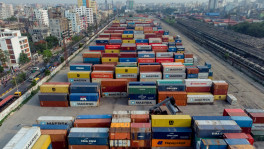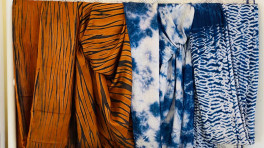Sweater emerges as next big bet as China exits market
Sweater has logged 27% export growth in the past six years

After retirement from the police, Mostafa Golam Quddus established a sweater factory in Bangladesh in 1987 – marking the country's entrance into the global sweater market mostly dominated by China at that time.
He flew in 43 Chinese experts for his factory and what happened next astounded the local business community – he exported products worth $3 million in the first year of the experimental start. Quddus's Cheung Hing Sweater has not looked back ever since.
The $3 million export has grown to more than $4 billion over time, and is expanding further as Bangladesh continues to gain more and more of the international sweater market.
Automated production lines now hum round the clock in nearly 400 sweater factories while manual hand flat knitting devices have been replaced by modern and automated Jacquard machines.
Pullovers, cardigans, jumpers and mufflers are included in the basic knitwear category.
Sweater has logged 27% export growth in the past six years as China pulled out from sweater-making, according to the Bangladesh Garment Manufacturers and Exporters Association (BGMEA). Exporters say the growth in this area is relatively higher compared to other items.
With a supercharged demand as economies reopened shaking off Covid fear, sweater-makers now eye fresh investment and factory expansion.
In 2021, there were five new investments while several sweater-making units expanded production capacity, says BGMEA Vice-President Shahidullah Azim.
Two entrepreneurs tell The Business Standard that they will put more money in sweater-making in the next two years. Shahidullah Azim also hopes investment in sweater manufacturing will increase in upcoming months.
Mostafa Golam Quddus, who had to hire Chinese workers for making sweaters, says creating a trained local workforce was a game changer for Bangladesh's business.
The former president of the BGMEA is now well-known for his Dragon Sweater, a knitting and spinning project he launched in 1993 after training the local workforce.
"Our success inspired many to invest in sweater making and paved the way for bringing in modern technology and upgraded machines," he notes.
Local entrepreneurs in expansion mood as China pulls out
With China as the major supplier, the current size of the international sweater market is around $104 billion. The other key players are Bangladesh, Cambodia, Turkiye, Vietnam and Myanmar.
Mohiuddin Alamgir Romel, managing director of Global Knitwear, says China is leaving the global sweater market owing to rise in production costs and because sweaters are a basic knitwear item. Bangladeshi entrepreneurs are to gain hugely in the upcoming years from the exit.
Designtex Knitwear, which now owns three factories, began producing sweaters in the 2000s. The owner of the company Khandoker Rafiqul Islam plans to increase investment in sweater-making by the end of 2022.
Rafiqul Islam, whose production units currently employ over 8,000 workers, tells TBS that the existing factories have increased their capacity in recent years rather than setting up new ones.
Mohiuddin Alamgir Romel also says they will scale up sweater investment – although he gives no details.
Low-cost items dominate the basket
Entrepreneurs say they mainly manufacture low-cost sweaters and export those for only $4-$6 per piece. Only a few factories export high-value items but in a low quantity.
Local sweater-makers can boost their earnings through making expensive items like "Cashmere wool sweaters", which are valued at $100-$150 apiece. Raw materials meant for producing it are available in India, China, and Mongolia.
Mohiuddin Alamgir Romel said an entrepreneur took an initiative to make this expensive item in his factory inside Cumilla EPZ but was not successful.
Bangladeshi makers now export sweaters made of acrylic fiber and some fashionable accessories to get some extra prices.
Some 20 to 25 factories are engaged in the large-scale export of sweaters in the country.
The list includes Pioneer Knitwear (BD) Ltd., Refat Garments, Square Fashions, Flamingo Fashion, Eurozone Fashion, Pakiza Knit Composite Ltd, AG Dresses Ltd. GMS Composite Knitting Ind Ltd, Nipa Fashion Wear Industry Ltd, AKH Knitting & Dying, Aswad Composite Mills, Cotton Club (BD), Matrix Sweater, Target Sweater, and Rupayan Sweaters.
Skilled sweater-maker crisis
Even more than three decades after the initial sweater-making journey, a severe scarcity of skilled workforce still dogs the entrepreneurs. The owners also said unusual price hikes of cotton in recent times also threw challenges at them.
Besides, they are lagging behind in terms of innovation, setting up design centres and a strong backward linkage.
To top it all, harmonised system code related complexities got in the way of raw material imports. Sweater-makers are also struggling to get orders from most of the big brands.
Moreover, a huge investment is required for setting up a factory in this sector, which is not possible for entrepreneurs with relatively small capital.
Mohiuddin said setting up a small factory with 200 machines would need $1.6 million on machines alone. As a result, investing in this sector is not easy.
This type of factory has to be kept running 24 hours a day, he said, adding at least half of these workers work at piece rates.
"The churn rate of these workers is high, which hampers production. Workers could be found easily in the past but now they have become scarce."


 Keep updated, follow The Business Standard's Google news channel
Keep updated, follow The Business Standard's Google news channel
















